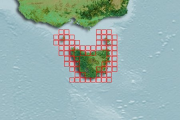Jasus edwardsii
Type of resources
Topics
Keywords
Contact for the resource
Provided by
Years
-
Carbon and nitrogen isotope data for J. edwardsii lobsters from eight sites in SE Australia.
-
Business structure and costs for Southern Rock Lobster fisheries in Tasmania including fixed (vessels, infrastructure) and variable (bait, fuel, ports) costs.
-

Describes the database used for storing Southern Rock Lobster (Jasus edwardsii) biological data collected by observers on commercial boats and dedicated research trips incorporating information on sex, length, weight, damage, reproduction, bycatch, protected species interaction, location, depth, tagging and equipment type.
-
To test if the carapace length of lobsters changes during cooking, 21 legal-sized southern rock lobsters were collected in pots from Alum Cliffs, south-eastern Tasmania, Australia in October 1999 (42.95±S 147.35±E). The sample consisted of 7 female and 14 male lobsters ranging in carapace length from 106 mm to 153 mm (mean 120 mm). Each animal was abdominally tagged using individually marked t-bar tags (Hallprint T-bar anchor tag, TBA1; Hallprint Pty Ltd, 27 Jacobsen Crescent, Holden Hill, SA 5088, Australia). The carapace length of all lobsters were measured five times to the nearest 0.1 mm in a random manner, before and after processing. This repeated measurement of all specimens in random order was intended to evaluate measurement error. Processing was typical of that used commercially and involved killing the lobsters in fresh water before cooking in pre-boiling salted water for 12 minutes.
-
Southern Rock Lobster (Jasus edwardsii) that are about to moult or have recently moulted have reduced market value due to higher mortality in live transport, higher cannibalism and lower meat recovery. Limiting the landing of softer shelled lobsters is desirable to maintain product quality. The effects of several factors on durometer readings were evaluated: sex, temperature (ambient plus elevated 3°C), location (from around the coast), and size (carapace length). Individuals were collected across two regions South Australia and Tasmania.
-

Southern Rock Lobster (Jasus edwardsii) biological data collected by observers on commercial boats and dedicated research trips incorporating information on sex, length, weight, damage, reproduction, bycatch, protected species interaction, location, depth, tagging and equipment type.
-
The movement and behaviour of the Southern Rock Lobster (Jasus edwardsii) was monitored using a radio acoustic telemetry systems at two sites in eastern Tasmania.
-
Using a telephone/diary survey methodology information about recreational fishing activity for rock lobster and abalone in Tasmania is monitored over a fishing season, with surveys conducted biennially. Information reported includes: date, location (fishing regions), method (pot, ring, dive), target species and catch (numbers of lobster and/or abalone). Sampling is linked to the recreational licensing database, managed by the state government.
-
The abundance of macroinvertebrates associated with 28 experimental artificial reefs supporting different patch sizes and density of kelp (Ecklonia radiata) off Maria Island, Tasmania. Macroinvertebrates were assessed by diver-based visual census conducted between November 2015 and December 2016. This data was collected to examine how the patch size and density of kelp influences the establishment of macroinvertebrate assemblages.
-
Predation mortality rates of blacklip abalone (Haliotis rubra) were estimated under several different conditions using a range of manipulative experiments. Abalone mortality rates were estimated from tethering experiments inside the Maria Island Marine Reserve (MIMR) and at an adjacent site where predators, including southern rocks lobster (Jasus edwardsii) were in low abundance, due to fishing. Estimates of abalone mortality directly attributed to rock lobsters were gained from manipulative experiments inside the MIMR and in an aquarium experiment at the Tasmanian Aquaculture and Fisheries Institute facility at the Marine Research Laboratories.
 IMAS Metadata Catalogue
IMAS Metadata Catalogue